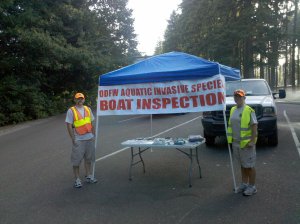I was returning from Devils Lake today and much to my surprise I spotted a “Boat Inspection Ahead” sign on the shoulder of I-5 near the Aurora rest area. The signs encouraged travelers to prepare to pull off at the rest area for a voluntary invasive species inspection. I was not transporting my boat but being the curious type I pulled off to see what I could learn.
Waiting for my arrival were two Oregon Department of Fish and Wildlife employees who were more than informative. This boat inspection stop is part of Oregon’s Aquatic Invasive Species program, which kicked off the end of May. The program has four new mobile inspection teams, which will visit some of the State’s busiest boat ramps this summer to help keep aquatic invasive species out. The Aquatic Invasive Species program is jointly operated by the Oregon Department of Fish and Wildlife and the Oregon State Marine Board.
In addition to appearances at popular boat ramps, the Oregon Department of Fish and Wildlife will put up these signs along Oregon highways asking boat-towers to stop for a voluntary inspection. There are no penalties for not stopping or not having a boat inspected. Nor are there penalties if invasive species (quagga or zebra mussels, New Zealand mud snails, Eurasian milfoil or other plants, etc.) are discovered during the inspection. The boat, however, must be cleaned by a decontamination team before it can launch in state waters.
If uninspected boats with invasive species are discovered launching, a new Oregon law allows fines up to $287. Inspections usually take about 10 minutes if boats are free of invasive species.
Boaters can help by:
It is important to remember that Devils Lake is one of the Oregon lakes that has been invaded by invasive species. The most mobile of these pests being the New Zealand Mud Snail , which easily attaches itself to boats that have spent time in our lake. To be sure you protect other Oregon lakes and follow these simple steps before transporting your boat.
- After boating, clean boat and gear thoroughly
- Inspect boats, trailers and motors for the presence of any aquatic species prior to and after use in any water body
- Remove all vegetation and discard in the trash
- Drain and flush the bilge, live well, bait buckets or any other internal compartments of any standing water
- Clean and scrub hulls, motors, anchors and trailers – then hose down with hot and/or high pressure water
- Allow cleaned boats to dry if possible for at least five days before using again
- Remember: Clean, Drain and Dry
Aquatic Invasive Species Prevention permits now required:
Boaters are required to have invasive species prevention permits. The penalty for not having a permit is $142. Oregon registered motorboats pay a $5 fee as part of their boat registration; a current registration decal is proof that the fee has been paid.
Non-residents who trailer a motorized boat into the state and launch in Oregon’s waters are required to purchase an annual non-resident permit for $22. Permits may be purchased on the ODFW Web site or at ODFW license agents.
Non-motorized boats (drift boat, canoe, kayak, etc.) 10 feet long or longer must have a permit onboard whether the operator is a resident or non-resident. Permits are $7 ($5 plus $2 agent fee) and may be purchased on the ODFW web site or at ODFW license agents. They are interchangeable, so the name on the permit does not matter as long as each boat has a permit. A person may also purchase multiple permits in their name for use by family members and friends. Children 13 years of age and younger are not required to have a permit.


There’s actually five teams in Oregon, the program started in January, and inspections take about five minutes if the boater practices “clean, drain, dry”.